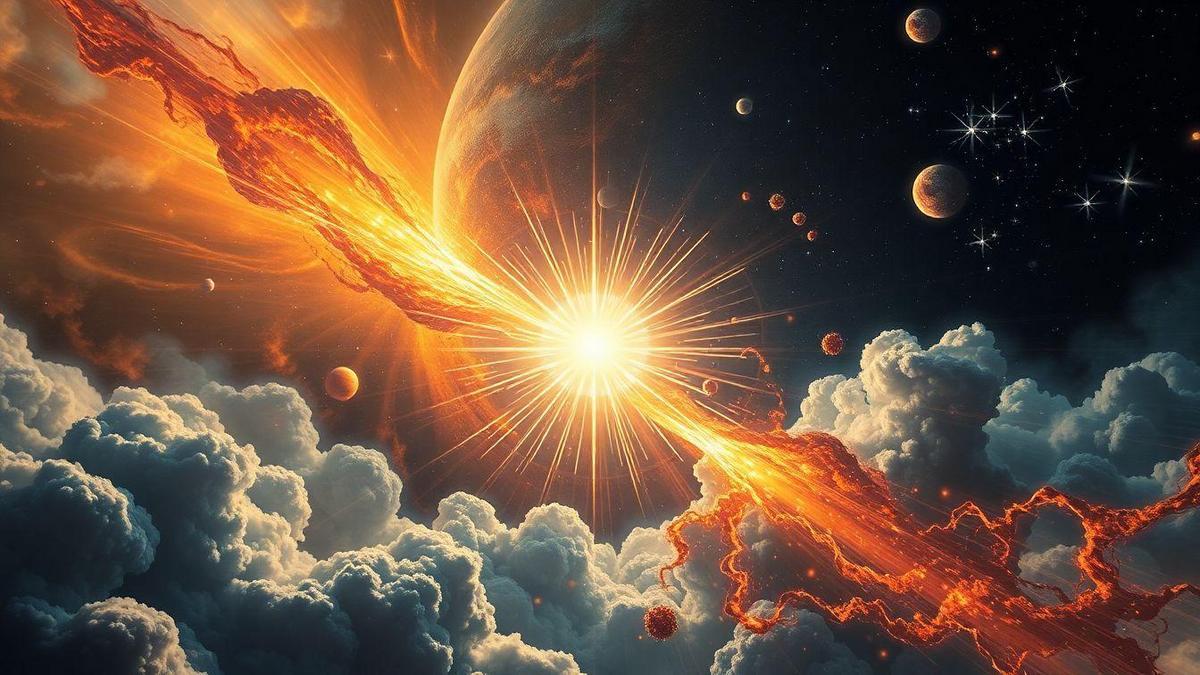
The role of iron in stellar death is a fascinating topic that touches on fundamental aspects of astrophysics and the evolution of the universe. Stars, true nuclear furnaces, undergo complex processes throughout their lives, culminating in dramatic events such as supernovae. Iron, one of the most abundant elements in the universe, plays a crucial role in this stellar life cycle, serving as an indicator of the final phase of a massive star. Understanding how iron forms and influences stellar dynamics is essential to unraveling the mysteries of the cosmos.
The death of a star is not merely an isolated event; it is part of a cosmic cycle that results in the formation of new elements and, consequently, the creation of new stars and planets. Iron, as the final product of nuclear fusion, marks the end of energy production in massive stars, leading to catastrophic collapses and explosions that scatter heavy elements throughout the universe. This article explores in depth how iron influences these processes and the implications of its presence in stellar evolution.
How Nucleosynthesis Processes Work in Stars
Nucleosynthesis processes in stars are responsible for forming chemical elements from lighter atomic nuclei. For most of a star’s life, it fuses hydrogen into helium in its core, releasing a tremendous amount of energy that counteracts the gravitational force trying to collapse it. As the hydrogen depletes, the star begins fusing helium into heavier elements, such as carbon and oxygen. This process continues until the core becomes predominantly iron, representing a critical point in stellar evolution.
Iron fusion is an energy-consuming process, unlike the fusion of lighter elements. When a massive star begins fusing iron, the energy generated is no longer sufficient to support internal pressure against gravity. This leads to core collapse, where temperature and pressure rise dramatically. The collapse results in a colossal explosion known as a supernova, which destroys the star and spreads heavy elements into space, enriching the interstellar medium.
After a supernova explosion, the synthesized elements, including iron, are dispersed through space. These elements become part of the material from which new stars and planetary systems form. Thus, iron not only marks the end of a star, but also is a vital component in the formation of new cosmic structures. This cycle of death and rebirth is fundamental to the universe’s chemistry and the formation of habitable planets.
Moreover, nucleosynthesis is not limited to supernovae. There are other processes, such as neutron capture, that also contribute to the abundance of iron and other heavy elements in the universe. Studying these processes is essential for understanding the chemical evolution of the cosmos and how elements are distributed over time and space.

Advantages of Understanding the Role of Iron in Stellar Death
Understanding the role of iron in stellar death offers several advantages beyond academic knowledge. First, this understanding is fundamental to astrophysics, as it helps explain how stars evolve and interact with their environment. The death of massive stars and the subsequent explosion of supernovae influence the formation of new stars and the chemistry of planets. Therefore, understanding iron and its nucleosynthesis is crucial for mapping the universe’s evolution.
Additionally, studying iron in stellar death allows scientists to develop more accurate models of element distribution in the universe. These models are essential for astronomy, as they help predict the chemical composition of distant galaxies and understand how those galaxies formed and evolved over time. Through the analysis of light emitted by these galaxies, astronomers can infer the presence of iron and other elements, revealing the history of nucleosynthesis in various cosmic environments.
Another important aspect is that research on iron and stellar death has direct implications for astrobiology. Understanding how heavy elements form and are distributed in the universe is vital for understanding planet formation and, consequently, the conditions that may lead to the emergence of life. Iron, for instance, is an essential component for life as we know it, being a key element in the biochemistry of many organisms.
Finally, studying the role of iron in stellar death provides an opportunity to develop technologies and methodologies that can be applied in other scientific areas. Astrophysics often uses modeling and simulation techniques that can be adapted to solve problems in fields such as particle physics, materials engineering, and even medicine. Thus, knowledge about stellar death and the role of iron can have repercussions far beyond astronomy.
How Iron Influences Stellar Evolution and Supernova Formation
Iron is the final product of nuclear fusion in stars. When a massive star reaches a state where fusing lighter elements is no longer energetically favorable, it begins to accumulate iron in its core. This process is the culmination of millions of years of nuclear reactions, where elements like hydrogen, helium, carbon, and oxygen have been progressively fused into heavier nuclei. Iron, being the most stable element in terms of binding energy, marks the point where nuclear fusion becomes unsustainable, leading to the star’s death.
The accumulation of iron leads to instability in massive stars. As the core fills with iron, the internal pressure can no longer support the gravitational force acting upon it. This instability causes a sudden core collapse, which contracts under its own gravity. The result of this collapse is a shockwave that propagates outward, resulting in a supernova explosion that can outshine entire galaxies.
Supernova explosions disperse heavy elements throughout the universe. During the explosion, not only iron but a variety of other heavy elements are ejected into space. These elements mix into the interstellar medium, contributing to the formation of new stars and planetary systems. This cycle of death and rebirth is essential for the universe’s chemistry, providing the ingredients necessary for the formation of rocky planets and, potentially, life.
Iron plays a crucial role in the formation of new stellar systems. After a supernova explosion, the ejected materials, including iron, become part of the gas and dust that eventually condense to form new stars. The presence of iron and other heavy elements is fundamental for planet formation, as they influence the chemistry and dynamics of the primordial material forming planetary systems.
Stellar gravity is affected by the presence of iron. The concentration of iron in a star can alter its internal structure and the way gravity acts upon it. This directly impacts stellar evolution and may influence how a star interacts with others in its environment. The presence of iron can also affect a star’s luminosity and temperature, altering its life cycle.
The study of iron helps to understand modern astrophysics. Research on the role of iron in stellar death provides valuable insights into the processes governing stellar evolution and galactic dynamics. This knowledge is fundamental for building theoretical models that explain the universe’s formation and the distribution of chemical elements over time.

Curious About the Role of Iron in Stellar Death?
Understanding the role of iron in stellar death opens the door to exploring the universe’s mysteries. This knowledge illuminates the processes that govern the life and death of stars, revealing how these events impact the formation of new planetary systems and the chemistry of the interstellar medium. Iron, therefore, is not just an element; it is a transformative agent that shapes the cosmos.
If you found this topic interesting, there are many other facets of astrophysics and stellar evolution to explore. The universe is a fascinating place, full of incredible phenomena that challenge our understanding and invite us to learn more. Continue your journey of discovery and delve deeper into the mysteries the cosmos has to offer.
Frequently Asked Questions
What is the role of iron in stellar death?
The role of iron in stellar death is very important. When a star dies, iron accumulates in its core. This accumulation leads to reactions that result in explosions like supernovae.
How does iron affect a star’s life?
Iron can no longer generate energy. This causes the star to become unstable. When the core fills with iron, it runs out of fuel and can no longer shine.
Why is iron the last element in stars?
Iron is special. It has the strongest fusion nucleus. After it, no more energy can be produced from nuclear fusion. This means it’s the end of the line for the star.
What happens to a star with too much iron?
A star with too much iron can explode in a supernova. This event releases a lot of energy and spreads elements into space. It’s essential for the creation of new planets!
Can the role of iron in stellar death create new elements?
Yes! During the explosion, new elements are formed. These elements spread through the universe and help create new stars and planets. The role of iron in stellar death is, therefore, the beginning of new cosmic cycles!





